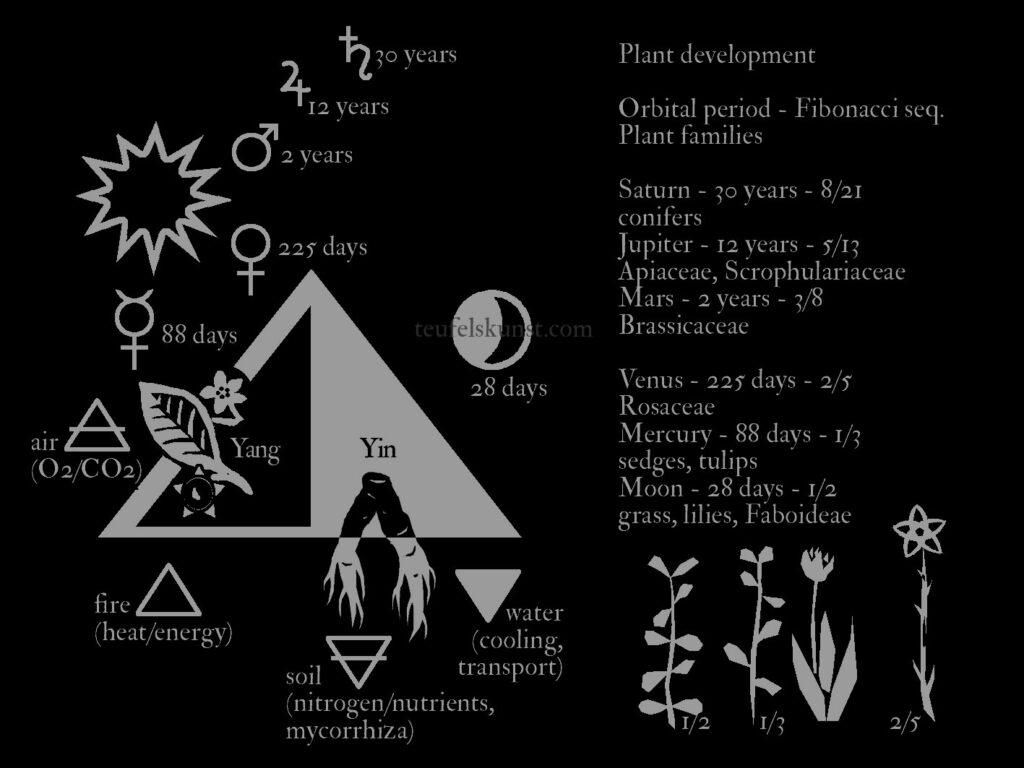
All plants grow towards the sun (helio- or phototropism) and use its light as energy source (photosynthesis). Hence the sun is the dominating factor in all plant life. However, the moon as the closest celestial body near to earth and its gravitational pull, especially on water molecules, influences plant development too, since plants are made up to 98% out of water. Plants are essentially structures or vessels built around water, which is required in all physiological processes.
The closer the moon is to the earth the stronger is its gravitational pull. This strongly affects water molecules, but also the earth’s solid surface. Every night the ground is literally lifted by the moon, yet this is hardly sensible. The sun too has a gravitional effect on earth. If sun, earth and moon align – either during a full or a new moon – this effect is even stronger and results in what is known as spring tide.
The moon hence also has an impact on the growth of plants. During the waxing phase the leaves develop stronger, whereas during the waning phase the growth is directed towards the roots. It is not clear how, but possibly this is due to gravitational changes.
The phenomenon that plants grow straight upwards, at an approximate 90° angle away from earth’s center, regardless of whether they grow on a straight plain or at the side of a hill, is called gravitropism. Better said, parts that grow above ground show a negative gravitropism whereas the roots show positive gravitropism, since they follow earth’s gravitational pull. This is directed mainly by the plant hormone auxin. (*see) Now, the moon’s gravitational pull interacts with earth’s own. During the full moon it gets stronger and thus may increase negative gravitropism in plants and support growth of leaves and stems, whereas during the waning moon it ceases and thus indirectly strengthens positive gravitropism, resulting in increased root growth. If and how the gravitational pull of moon and other celestial bodies influence gravitropism has yet to be studied in detail. But experience shows the following picture:
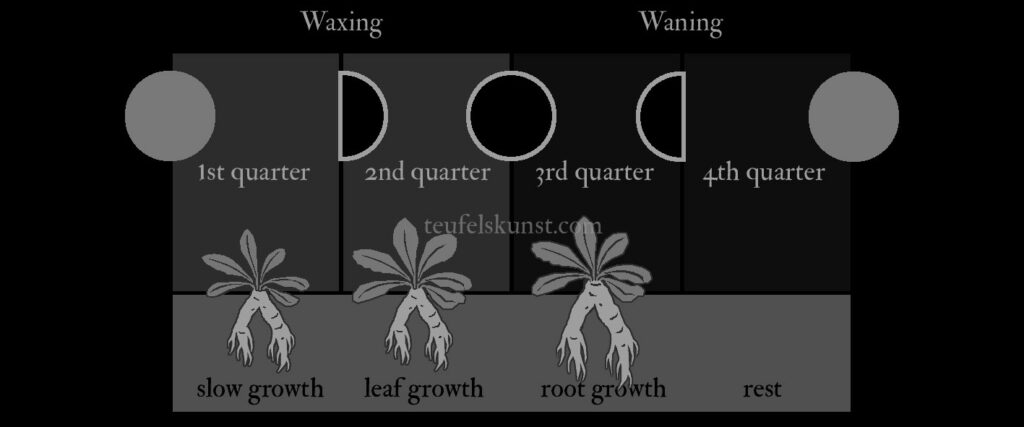
The observance of the moon and the sky has been employed by agricultural societies and gardeners ever since. However, when referring to a lunar phase or month, it must be clarified which moon is actually meant…
Some terminology….
- synodic month – the time from one new moon to the next (as shown above) ~ 29d 12h 44m = 29,530 days
- sidereal month – return to the same star or the time it takes for the moon to travel throught the zodiac signs (shorter than a synodic month) ~ 27d 7h 43m = 27,321 days
- tropical month – depending on the vernal equinox this lunar month is slightly shorter than a sidereal lunar month and significantly shorter than a synodic lunation ~ 27d 7h 43m = 27,321 days
- draconic month or nodal period – the return to the same lunar node ~ 27d 5h 5m = 27,212 days
The tropical month is of special relevance in farmer’s almanacs. As opposed to the synodic waning and waxing moon the focus lies here on the diurnal arc of the moon, which is the path the moon draws on the daytime sky. During the first half of a tropical month the moon’s arc is daily getting closer to the horizon line; the moon is “falling” or is nidsigend. During the second half, the moon’s arc is daily increasing and moving further away from the horizon line; the moon is “rising” or obsigend. Both periods last around 14 days. The nidsigent moon is symbolized by an upside down crescent, the obsigent moon is pictured by an upwards pointing crescent, which resembles a bowl.
Btw. the word tropical comes from Greek tropos = “turn”, the terms nidsigend and obsigend come from Alemannic dialect and mean ascending and descending.
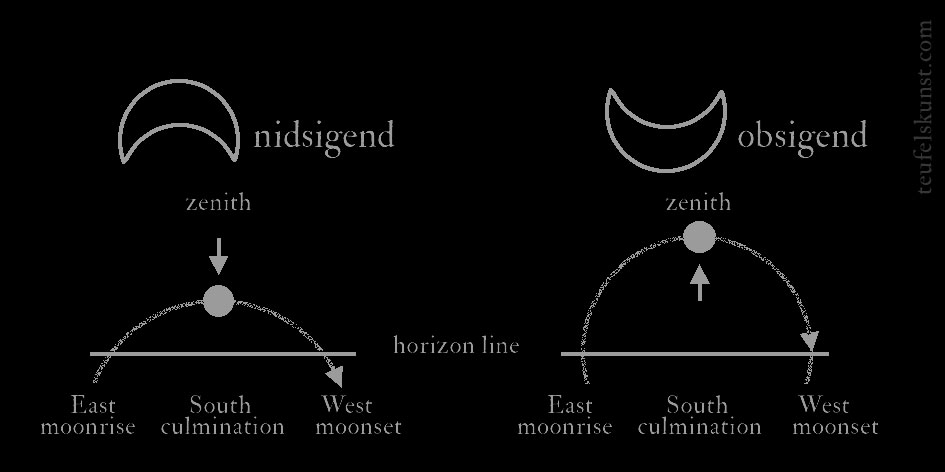
Related names, coming from Hawaiian mythology, are “wet moon“, where the upwards pointing moon is likened to a bowl catching up falling rainwater during the winter, and “dry moon“, where the lunar sickle turns upright as summer is approaching and pours out the collected water in the form of summer rains. The wet moon is also pictured as a smile and is called “Cheshire moon” after the grinning cat from Alice in Wonderland. Notably, these names apply to the actual shape and orientation of the sickle moon, not to its culmination on the daytime sky.
According to folk saying, root growth is supported by the nidsigend moon and leaf growth by the obsigend moon. Hence, root vegetables and plants that grow mainly subterranean should be planted during the nidsigend moon. All other vegetables and plants that produce crops above ground should be planted during the obsigend moon. Further, the nidsigend moon is in general considered the favorable phase for planting and separating young plants, since it promotes rooting. The obsigend moon is the phase during which the plants grow in height.
Again, the nidsigend and obsigend moon are not to be confused with the waning and waxing phase.
Taking things further, one would now observe the sign the moon is in and apply these to the different parts of the plant according to the elements, meaning earth signs for roots, water signs for leaves, air signs for flowers and fire signs for fruits and seeds. Eg root plants should be sown when the moon is nidsigend and in an earth sign, flowering plants such as sunflower would be best sown when the moon is nidsigend and in an air sign and so on.
To give an example, the planting times for August and September 2024 would look as follows:
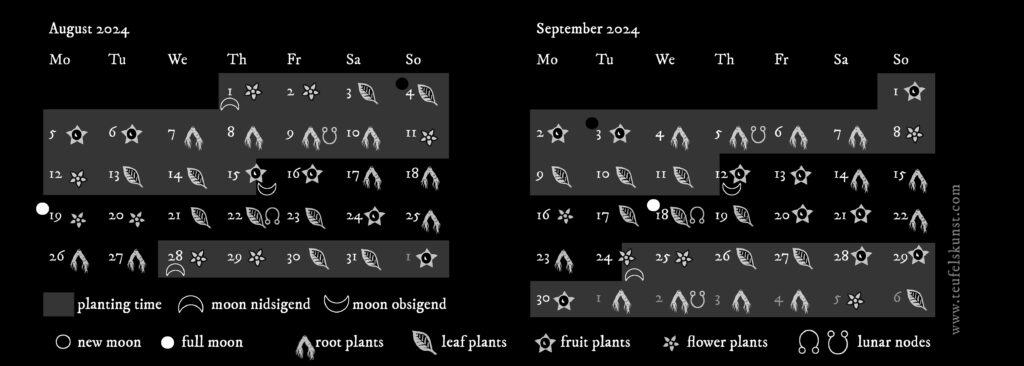
Besides, the days when the moon meets one of it’s orbital nodes (when it crosses the ecliptic), should be avoided for any greater gardening activity and no seeds should be sown then. These lunar nodes are also known as head and tail of the dragon, whereby the head corresponds with the ascending = Northern node above and the tail with the descending = Southern node below the ecliptic.
Seeking out the best time for planting can become a challenge. The moon may be waning and in an earth sign (perfect for roots), but obsigend and thus not favorable for planting. So you wait until the moon is nidsigend and in an earth sign, but alas, the moon is waxing and in addition, the moon is in one of its nodes or draconic. It is said, that lunar nodes should be avoided for any gardening activity.
Luckily there are lunar calendars available online and in printed form. For further reading see the writings of Maria Thun, who has dedicated her life to gardening with the moon and the zodiac.
Take notes in a personal gardening diary, in which you write down your activity, day and time. Add the moon phase and sign and other aspects, which you can also look up and add later.
The microcosm of the plant mirrors the macrocosm of the universe in movement; as above so below.
Other factors that might impact the development of a plant may be constellations of sun, moon and the planets. This delving into an actual plant astrology since, apparently there is a correlation between the orbital period and the pattern that a planet draws when it circles around the sun and the growth pattern of plants and fruits. More precisely, both orbital period and plant growth follow Fibonacci sequences… (see first illustration)
For the nerd….
The orbital period is the time the planets need to return to their starting point when revolving around the sun. Plants mirror this movement pattern for example in the way in which their leaves are arranged around their stems. These patterns are also found in the way how the seeds are packed on sunflowers or pine cones. The succession in which planets orbit and leaves revolve around the stem follow infact the sequences that Fibonacci introduced to Western European mathematics.
Annual or short-lived and fast developing plants are influenced by the Moon and the sub-solar planets Mercury and Venus. They are sown in spring and brought outdoors after the last frosts. Some annual plants, ie poppies, can also be sown in late summer and then behave as biennials.
Biennial plants may be under the influence of Mars or slower revolving planets. They are best sown in July/summer – the warmest and brightest time of the year. They often produce a basal leaf rossette and long root during the first and a large stem, flowers and fruits during the second year.
Perennial plants can be grouped under Jupiter and Saturn, and under the latter especially shrubs and trees. They are best sown in autumn and often require cold periods ahead of germination. These slow growing plants often take 2-3 years before starting to flower and producing seeds.
Taking things even further, one could create a natal chart for all gardening activity or follow other rules for planetary magic such as are outlined in Picatrix. But rather than getting entangled in astrological theory, better tend to your garden and perhaps and foremost consult the plant devas themselves.
Least we forget…
Plants respond to the individual. Sometimes we are just not ready yet for certain plants and they may come to us at a later point – not when we think that we need them, but when we or perhaps also the creatures around us do. That is when a plant may suddenly occur in nature to us, even repeatedly, or when a seed, we have forgotten in a pot or flower bed suddenly germinates. The passionate gardener not only tends to the physiological needs of the plants (which are usually dealt with during day time) but also comes back to the garden at night, for feeding the devas, elves and gnomes that inhabit the soil, stones and vegetation. This way the plants help us reconnecting spiritually to our selves and beyond.
For further info on plants, seeds and gardening please visit my garden blog at https://pflanzenkunst.wordpress.com
May 3, 2024
Posted In: Garden, Herbs & Seeds
Tags: gardening, nidsigend, obsigend, planetary correspondences, fibonacci, planetary magic, lunar garden, plants and planets, synodic moon, sidereal moon, draconic moon, seeds, lunar nodes, sowing, tropical month
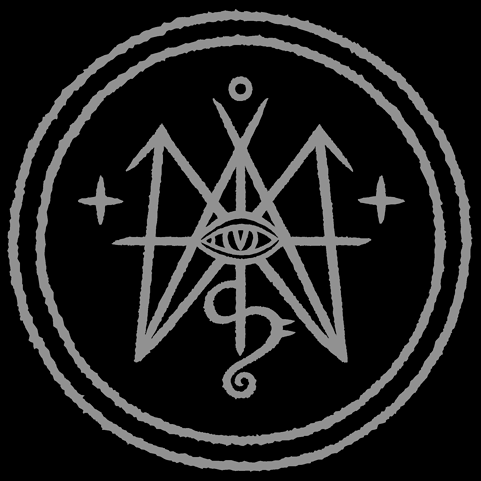
Leave a Reply